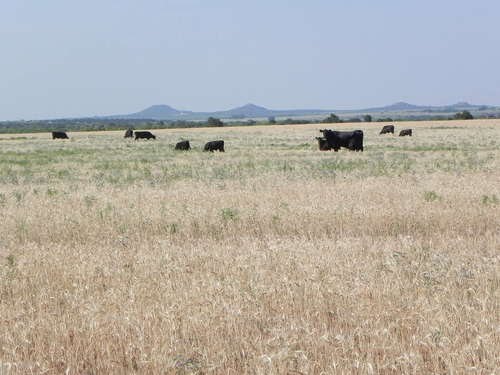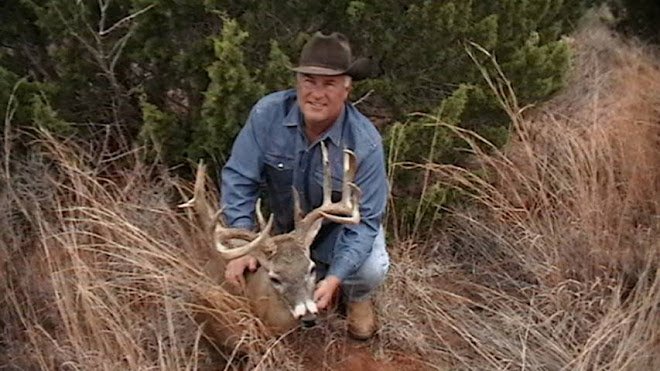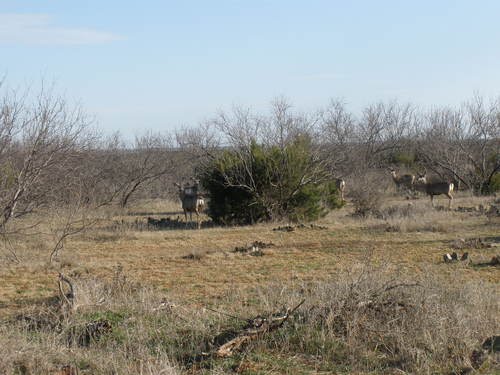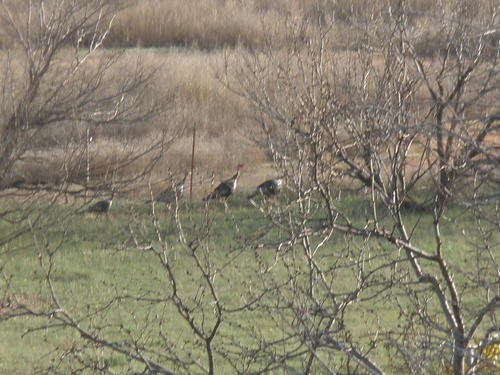The Battle of Pease River
In early 1860 Peta Nacona led the Comanches in a raid through Parker County, Texas, which ironically was named in honor of his wife's family. After the raid he returned with his band to what he believed was a safe retreat under the sandstone bluffs of Pease River near where Mule Creek flowed into the stream. The site was long a favorite of the Comanche, providing both cover from the fierce blue northers that hit the plains, and ample forage for their ponies, with easy buffalo hunting from the nearby herds. But the raids of the Comanche had brought pressure in Austin to protect the settlers, and Texas Governor Sam Houston had commissioned Ranger Captain Sul Ross to organize a company of 40 Rangers and 20 militia to put a stop to the Indian raids. The company of 60 was based at Fort Belknap, in Parker County.
Sul Ross quickly ascertained that he simply did not have sufficient men to guard the frontier,[6] and instead determined that the best way to protect the settlers was to take the offensive to the Indians at the earliest opportunity. In preparation, he began to scout the area for sign of Indian camps. After Peta Nocona's raid into Parker County, Sul Ross and his fighters started tracking the Nokonis, who were considered the hardiest fighters among the Comanche, who were in turn considered the fiercest of the Plains Indians.
Modern research has revealed that Peta Nocona did not intend to stay at Pease River, and was preparing to move on when the attack came on his camp that December day.[3] It was daybreak on December 18, 1860, when Ranger Captain Sul Ross himself scouted out the camp on the Pease River as his scouts reported the presence of a fairly large hunting party and camp on the banks of the Pease. With an oncoming blue northern blotting out sign, Ross was able to move up to spy out the location of the Noconas on the Mule Creek head bank as it came into the Pease River.
Ross sent a detachment of 20 men out of his force of 60 to position themselves behind a chain of sand hills to cut off retreat to the northwest, while with 40 men, Ross himself led the charge down into the Indian camp. The result was that the band was taken completely by surprise, and were massacred, either shot down where they stood, or were killed by the 20 men to the north as they attempted to flee. Sul Ross wrote, quoted in Indian Depredations, by J.W. Wilbarger, that they fired at everyone present, saying "The attack was so sudden that a considerable number were killed before they could prepare for defense. They fled precipitately right into the presence of the sergeant and his men. Here they met with a warm reception, and finding themselves completely encompassed, every one fled his own way, and was hotly pursued and hard pressed."
Cynthia Ann Parker and her daughter in 1861 after their capture at Pease River in a picture which was famous all over the United StatesThere are two distinct and very different stories about Peta Nocona’s death. The first is that he died trying to escape with his wife and infant daughter, which is the generally believed story, and the one reported by Sul Ross officially. According to this story, seeing that the camp was hopelessly overrun, Chief Peta Nocona and Cynthia Ann Parker fled to the east up a creek bed. Reportedly, mounted behind Nocona was a 15-year-old Mexican girl, while Cynthia Ann Parker carried her two year old child, Topasannah (“Prairie Flower”). Captain Ross and his lieutenant, Tom Killiheir, pursued the man they believed to be the legendary Peta Nocona. But Quanah Parker, the chief's oldest son, once reportedly said in Dallas to Sul Ross, "No kill my father; he not there. I want to get it straight here in Texas history. After that, two year, three year maybe, my father sick. I see him die."[7] Certainly Quanah Parker said on numerous occasions to both friend and foe that his father had survived the massacre of his Band, and died three to four years later of complications from old war wounds suffered against the Apaches. In this story, strongly supported by the Comanche people, Peta Nocona was out hunting with his oldest son and a few others when the attack occurred. This story is supported also by an Army Colonel who reported interviewing reliable men who saw Nocona after his supposed "death" at Pease River.
In the official story as reported by Sul Ross, after a chase of a mile (1.6 km) or so, he and Ranger Tom Killiheir hotly pursued a man they thought was a chief from his headdress, who had a second Indian on the back of his pony, and a second pony with a woman carrying a small infant. The Rangers pulled up and either (Ross claimed he shot the man, Killiheir said he did, one of the two shot the second Indian on the back of the chief's pony. It turned out to be a Mexican girl on the back of Nocona’s pony, and both white men would later claim that they did not know she was a girl, with only her head showing out of the buffalo robe. She was killed instantly by the shot, and as she died, pulled the chief, supposedly Peta Nocona, off the horse. The Comanche chief recovered and began to fire arrows at the approaching Ross, one striking the horse on which the Ranger captain was mounted. One shot from Ross’s pistols reportedly broke Nocona's arm, while two other shots reportedly hit his body. Apparently mortally wounded, Nocona managed to drag himself to a small tree and bracing himself against it began to chant the Comanche death song. [2] Captain Ross's Mexican-born servant, Antonio Martinez, who spoke Comanche, and reportedly had been taken captive as a child by Nocona, [3] approached the dying warrior and spoke to him in the Comanche language. As an interpreter for Captain Ross, Antonio Martinez told Nocona to surrender. The fierce Comanche’s response was a dying attempt to hurl a lance at the Ranger leader. His family captured—except for his son Quanah, who had escaped the slaughter—and his warriors dead or dying, their families dead or prisoners, Nocona was executed on the spot by a shotgun wielded by Martinez, while the woman supposedly screamed his name and wept. It is notable that Sul Ross made himself a huge hero by killing the legendary Comanche Peta Nocona. Nocona's death helped ensure the safety of the settlers, who for years had to fear massacres and unjust attacks.
However, once he had come in to the reservation, and the topic arose with him, Quanah Parker adamantly denied that the man killed with his mother was his father. Further, Quanah Parker had told his fellow warriors for years that his father had made good his escape from Pease River, and had died years later. Quanah said that he and his father, along with a few others, had left the camp late the night before to go hunting, and thus were not present the morning of the massacre of their band, and when they returned, virtually no adults were left alive to tell him or his father exactly what had taken place, or what had become of his wife and two youngest children. Not knowing whether his wife and youngest children were even alive, Peta Nocona made the hard decision to flee the place of the slaughter of his people, in order to assure the safety of his remaining (and oldest) son. According to Quanah, Ross did not know who the man he killed was, and his father was away with him, and virtually all the warriors when the attack occurred, and lived four more years, before old battle wounds finally killed him. [4] The only things known for sure about Pease River is that the vast majority of the band who were present were slaughtered, and that Cynthia Ann, and her daughter were captured. Her sons unquestionably got away, though Pecos died later from illness, reportedly smallpox. Whether Peta Nocona died at Pease River, or got away, will never be known.[8].
It must be also noted that a rare book from that period supports Quanah's claim that his father did not die at Pease River. In a book decades out of print, written in 1890, Carbine & Lance, The Story of Old Fort Sill, by Colonel W.S. Nye, the Colonel buttresses Quanah's version of the story. Ney says: "Accounts vary as to what happened. Captain Ross, who was acclaimed a hero for the deed, claimed and probably honestly believed that he had caught and killed Peta Nacona. But in the melee he pursued and shot Nawkohnee's Mexican slave, who was trying to save the fleeing Comanche women." Nye claimed that he encountered men who saw Nocona alive several years after Pease River, when he was ill with an infected war wound. This version strongly supports Quanah's claim that his father survived Pease River, and died three to four years later of an infected wound. Nye said what Quanah maintained, that Nocona and Parker had been an exceptionally happy couple, and the forced separation killed them both, Parker starved herself to death, and Nocona withered away.
Subscribe to:
Post Comments (Atom)


















No comments:
Post a Comment